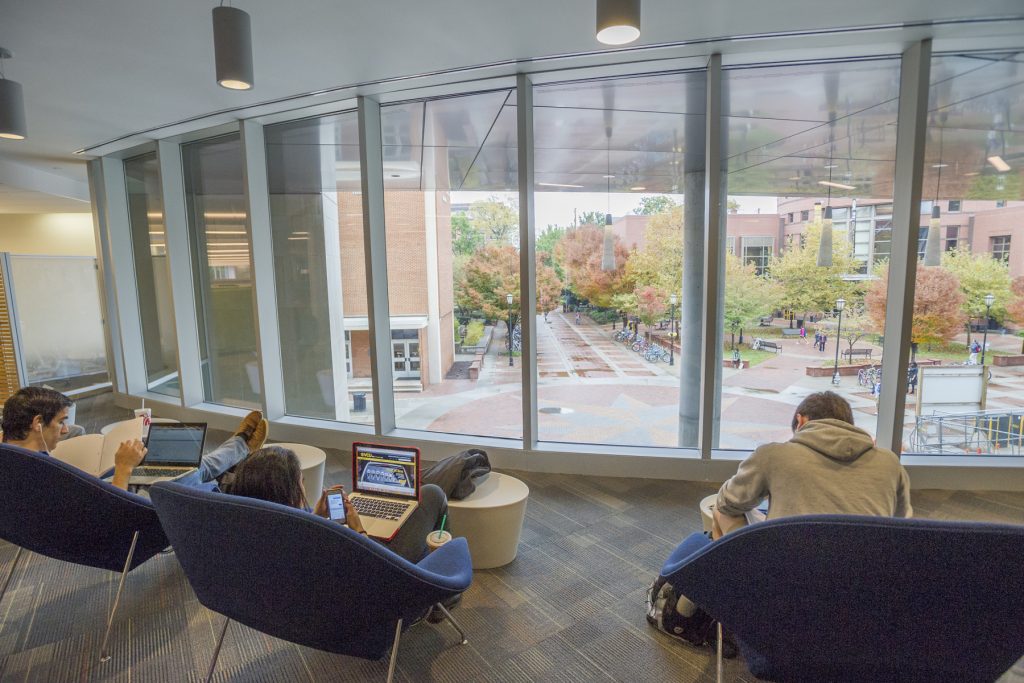
VCU reopened a part of its main Monroe Campus library after heavy renovations. Images courtesy of VCU.
The noise of construction that has surrounded VCU’s main library for nearly two years is beginning to quiet.
The university fully reopened the first two floors of the James Branch Cabell Library on its Monroe Campus on Monday, nearing the finish line for a $50.8 million renovation and expansion that started in December 2013.
Work on the third and fourth floors will continue through December, with those areas opening in time for the spring semester.
The state-funded project adds 93,000 square feet of new space to the building for a new total size of 333,000 square feet. An additional 63,000 square feet of existing space was renovated as part of the project, which was designed by Shepley Bulfinch and Moseley Architects. W.M. Jordan Co. is the general contractor.
Built in 1970, the building was expanded to five floors in 1975 but has become overcrowded, with the number of library visitors doubling to more than 2 million annually over the past decade.
The addition and renovations add more than 1,000 new seats, computers and work spaces, with 90 percent of the space intended for student use specifically.
On top of the additional space, improvements include a new media studio, which features tools such as 3-D printers and scanners, laser cutters, and robotics. The new studio will open in early spring in the library’s lower level.
“The new building is filled with features, innovations and architectural beauty that I think capture and express the immense pride we all have in our university,” University Librarian John Ulmschneider said in a release. “It reflects the maturation of VCU over the past 20 years – a building that almost shouts to everyone who enters it: VCU has arrived.”
The project is also expanding a Starbucks on the first floor and adding an event space on the third floor with seating for up to 300, among other features inside and outside.
The state is covering the project’s $50.8 million price tag, and the library is aiming to raise an additional $10 million from private donors to support some building costs and provide future endowments.

VCU reopened a part of its main Monroe Campus library after heavy renovations. Images courtesy of VCU.
The noise of construction that has surrounded VCU’s main library for nearly two years is beginning to quiet.
The university fully reopened the first two floors of the James Branch Cabell Library on its Monroe Campus on Monday, nearing the finish line for a $50.8 million renovation and expansion that started in December 2013.
Work on the third and fourth floors will continue through December, with those areas opening in time for the spring semester.
The state-funded project adds 93,000 square feet of new space to the building for a new total size of 333,000 square feet. An additional 63,000 square feet of existing space was renovated as part of the project, which was designed by Shepley Bulfinch and Moseley Architects. W.M. Jordan Co. is the general contractor.
Built in 1970, the building was expanded to five floors in 1975 but has become overcrowded, with the number of library visitors doubling to more than 2 million annually over the past decade.
The addition and renovations add more than 1,000 new seats, computers and work spaces, with 90 percent of the space intended for student use specifically.
On top of the additional space, improvements include a new media studio, which features tools such as 3-D printers and scanners, laser cutters, and robotics. The new studio will open in early spring in the library’s lower level.
“The new building is filled with features, innovations and architectural beauty that I think capture and express the immense pride we all have in our university,” University Librarian John Ulmschneider said in a release. “It reflects the maturation of VCU over the past 20 years – a building that almost shouts to everyone who enters it: VCU has arrived.”
The project is also expanding a Starbucks on the first floor and adding an event space on the third floor with seating for up to 300, among other features inside and outside.
The state is covering the project’s $50.8 million price tag, and the library is aiming to raise an additional $10 million from private donors to support some building costs and provide future endowments.



